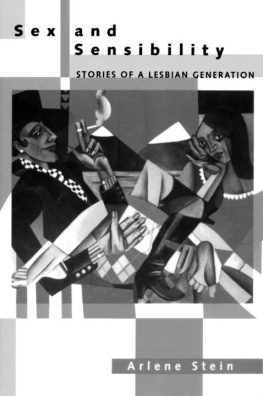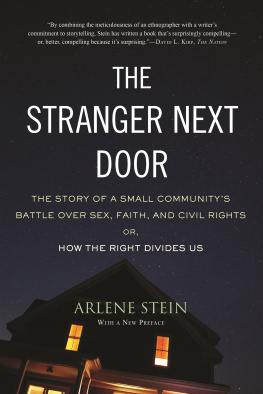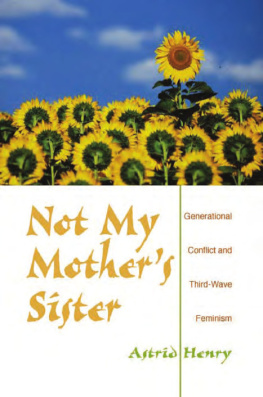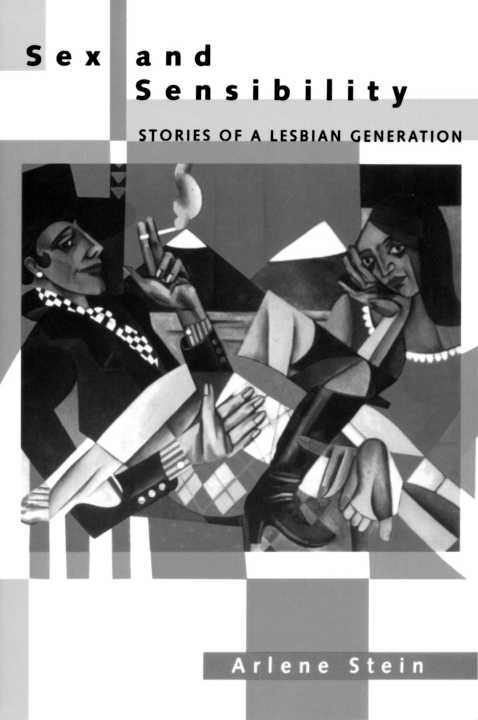ARLENE STEIN





For my nwther, and in memory of my father
The roots of this book lie in the lesbian/gay community of San Francisco, as well as in the emerging international community of lesbian/ gay scholars. As I began the research, I was fortunate to be associated with Out/Look magazine and the San Francisco Gay and Lesbian History Project, which provided a lively forum for discussing lesbian/ gay history and sexual politics.
Nancy Chodorow encouraged me to pursue a study of lesbian identities, helped me to hear women's voices more clearly, and provided incisive feedback along the way. Her intellectual challenges strengthened this project in numerous ways. Anita Garey and Karla Hackstaff provided valuable support and direction during the writing process. Steve Epstein helped clarify my thoughts about many things.
The Lesbian Herstory Archives in New York and the archives of the Gay and Lesbian Historical Society of Northern California gave me access to many original source materials. At various points, Robert Bellah, E. G. Crichton, Josh Gamson, Deborah Gerson, Alexis Jetter, Miriam Johnson, Liz Kotz, Susan Krieger, Louise Lamphere, Kristin Luker, Ruth Mahaney, Annelise Orleck, Rachel Pfeffer, Steven Seidman, Terry Strathman, and Carla Trujillo offered contacts, helpful suggestions, or critical comments that proved valuable. Vera Whisman shared with me her related work in progress. Audiences at the University of California at Santa Cruz, at Dartmouth College, at lesbian/gay/bisexual studies conferences at Rutgers University, and at the University of Amsterdam challenged me to rethink parts of my analysis.
Jeffrey Escoffier, who first introduced me to the study of sexual identities in a course he taught at Berkeley, read and commented on the manuscript as it was nearing completion, as did Deborah Gerson, Sabine Hark, Elizabeth Lapovsky Kennedy, Ellen Lewin, and Ann Weinstone. Naomi Schneider, Will Murphy, and Nina D'Andrade at the University of California Press ably guided me through the process of preparing the manuscript for publication. I am indebted to them all.
The Woodrow Wilson Foundation provided initial financial support for my research, as did a fellowship at the Doreen B. Townsend Center for the Humanities at the University of California, Berkeley. For nearly two years, the Department of Sociology at the University of Essex, England, provided good company and challenging students. At Essex I was fortunate to have worked with and alongside Ken Plummer and Mary McIntosh, whose pioneering work on the sociology of homosexuality inspired my own modest contribution. During the last two years, the Department of Sociology at the University of Oregon has been a stimulating home. A faculty research grant from the University of Oregon aided the completion of this manuscript.
Nancy Solomon kept a roof over my head and food on my plate, gave me periodic pep talks, provided a sounding board for my ideas, and read and commented on the manuscript in its final stages. Without her, this book would never have seen the light of day.
Finally, I am very grateful to the women whose voices appear in these pages, who gave me their time for little in return. I hope that I have done justice to their stories.
An earlier version of the chapter "Difference, Desire, and the Self: Three Stories," was published in Women Creating Lives: Identities, Resilience, and Resistance, ed. Carol Franz and Abigail Stewart (Boulder: Westview, 1994). Portions of this book also previously appeared in "Sisters and Queers: The Decentering of Lesbian Feminism," Socialist Review 22, no. 1 (1992): 33-55.
These are the stories of women who imagined new forms of gender and sexuality that centered on women-and how their imaginations sometimes ran ahead of their capacities to change themselves and their world. Members of the postwar baby boom generation, some seventy-five million strong, lived their formative years during a period of tremendous change. The civil rights, anti-Vietnam War, and feminist movements, events that were radically at odds with their childhood and early adolescent experience during the staid and settled 1950s, challenged many of their assumptions about how America was organized.
Through their activities in the feminist movement, some members of this generational cohort became, in the early 1970s, among the first to boldly declare themselves lesbian. They marched in the streets, encouraging others to come out and join them and affirming that which had been forbidden. They created a culture that proclaimed lesbianism as a viable sexual and lifestyle choice. They promised to transform identities and give women a new sense of self. Lesbian feminism, and the social and cultural challenges it posed, irrevocably changed the American sexual landscape.
Today, twenty-five years later, the legacy of this period and of the generation that shaped it most, the baby boomers, has become a highly contested subject. As the vision of a Lesbian Nation that would stand apart from the dominant culture, a haven in a heartless (male and heterosexual) world, recedes, the collective memory of lesbian feminism has become a symbolic battleground.
On one side are those who wish to complete the unfinished lesbian feminist project. "We used to talk a lot about lesbianism as a political movement," philosopher Janice Raymond lamented, "back in the days when lesbianism and feminism went together, and one heard the phrase `lesbian feminism.' Today we hear more about lesbian sadomasochism, lesbians having babies, and everything lesbians need to know about sex."' She and others wish to reinvigorate a collective sense of lesbian selfhood, which they view as a bulwark against male domination and compulsory heterosexuality. Strong believers in a politics of identity organized around a collective definition of lesbianism, they consider the current diversification and fragmentation of lesbian communities to be frightening developments, fostering lesbian invisibility and silence and threatening individual selfhood.
On the opposing side are those who cast lesbian feminists and the "lesbian community" as the repressive mother who stands in the way of sexual pleasure and imposes uniformity on the diversity of desires, identities, and practices. As one woman, writing to the editor of a lesbian/gay journal, suggests: "Lesbians are doing and talking about things we have never done or talked about before... that the selfrighteous atmosphere of political correctitude and erotophobia we called lesbian-feminism kept us from uttering."2 She suggests that the label lesbian is a fiction, a means of social control that has been foisted upon certain women by the medical establishment, and one that many lesbians, particularly lesbian feminists, have accepted unquestioningly. In response, she and others call into question all settled notions of homosexuality, emphasizing the differences, discontinuities, and flux within the group of women who call themselves "lesbian."





